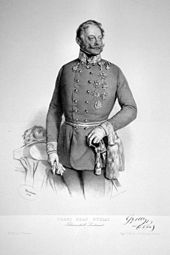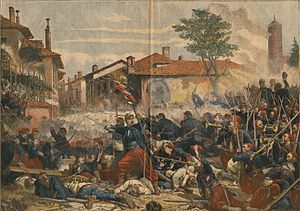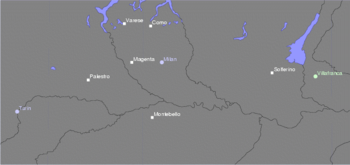Battle of Magenta
| date | June 4, 1859 |
|---|---|
| place | Magenta , Lombardy |
| output | Franco-Sardinian victory |
| Parties to the conflict | |
|---|---|
| Commander | |
| Troop strength | |
| 49,945 infantrymen 1,207 cavalrymen 87 guns |
58,183 infantry 3,435 cavalry 152 guns |
| losses | |
|
4,585, of which 707 were killed and 655 were missing |
10,226, of which 1,368 were killed and 4,500 were missing |
The Battle of Magenta on June 4, 1859 was a battle in the Sardinian War between the Empire of Austria and the Kingdom of Sardinia-Piedmont and its allies France under Napoléon III.
prehistory
On 29 April 1859, the invasion of took place Austrians under the command of Feldzeugmeister Count Ferenc Gyulay in the Piedmont , they sat down on the line from Biella to Pavia firmly. After the battle at Montebello on May 20, the French carried out a flank march northwards behind the Piedmontese. Feldzeugmeister Gyulay was mainly concerned about his left wing and that it would not be circumvented by crossing the allies over the Po below his position. On May 29, the Franco-Sardinian army counterattacked. After the battle of Palestro and Vinzaglio, the road to Milan was clear for the allies . As a result, the French army was able to concentrate with the Piedmontese at Novara on June 3rd . When Gyulay found out about it, he withdrew to the left bank of the Ticino and took a position between Magenta and Abbiategrasso .
Preliminary battles at Boffalora and Turbigo on June 3rd
On the morning of June 3, the French crossed Ticino, the Guard Corps attacked parts of the Clam-Gallas Corps near Boffalora , and the French 2nd Corps opened the battle of Turbigo further north . In uncertainty about the intentions of the enemy, Emperor Napoléon III wanted . expand the eastern bank of Ticino on the 4th without giving up the strong concentration of troops set up to deceive the enemy at Novara . There, the 1st Corps (Marshal Baraguay ) had leaned against the Agogna as the right wing of the battle front, as well as covering the Desvaux cavalry division. The 4th Corps (General Niel ) coming from Novara had to form the center at Trecate and the cavalry division of General Partouneaux had to maintain contact with the 1st Corps after Olengo. As a reserve, the Sardinian army and the two remaining cavalry divisions were concentrated at Galliate . June 4th was the day of rest for the Austrian troops not yet in combat, but the army chief of staff Heinrich von Hess urged Gyulay to attack the enemy at Magenta the next day in order to avert the imminent loss of Milan .
The battle on June 4th

When the French guard troops advanced on June 4th near Sant Martino via Ticino on to Lombard territory, the battle of Magenta broke out. Napoleon III ordered the Austrians to attack with six brigades of the guard without being able to take up the enemy position; the troops themselves quickly got into trouble. In the meantime, in addition to the French 2nd Corps from the north and the 3rd Corps under Canrobert from the west, the French were able to assert themselves on the battlefield. The Guard Corps at Buffalora under Regnaud de Saint-Jean d'Angely was now to remain in the second line and give way to the troops of the 2nd Corps under Mac-Mahon. General de La Motte-Rouge's division, destined to attack Magenta, advanced into the front line of battle via Casate and Boffalora, followed by the division under Espinasse . General Mac Mahon was instructed to take Magenta and to establish a connection with the 3rd Corps via the bridge of Sant Martino, a light cavalry brigade had to form the left wing of the army east of Magenta.
The bridge position of the Austrians on the Naviglio Pavese , the Great Canal running parallel to Ticino near Pontenuovo and Buffalora, which was held by the brigades of the major generals of Burdina and Baltin , was also reinforced by the regiments of Colonel Wernhardt and Count Hartmann. At about 7:00 a.m. the Austrians noticed that the enemy line-up had been strengthened by the advance of the fresh Guards Division under General Émile Mellinet . From the second meeting, the Austrian brigades Szabo and Koudelka advanced and were used as reinforcement closer to the Naviglio. After the Austrian I. Corps under Count Clam-Gallas forwarded the threat to the Feldzeugmeister, Count Gyulay immediately sent orders to the V and VIII Corps north of the Po to resume the march and the troops of I and II fighting northwards III. Support corps. As a reserve, Count von Mensdorff's cavalry division was immediately ready for action between Corbetta and Magenta .
On the northern section of the front, the Sardinian 2nd Division under General Fanti had crossed the Tessino completely by 9:00 a.m. at Turbigo and was waiting on the eastern bank for a French division of Marshal Canrobert to approach. Because of this delay, the Sardinian 3rd Division under General Durando did not cross the river until noon. When the Espinasse division on the French left wing and the Picard division on the right wing had intervened in the battle, around 35,000 Austrians faced around 40,000 opposing troops before noon. The Baltin Brigade, advanced near Boffalora, heard the noise of the battle of the Mellinet division attacking at Magenta behind and ran the risk of being completely cut off after de La Motterouge's division pushed into the flank from the north. The Austrians were pushed back at Pontenuovo, Major General Burdina fell, the Hartung Brigade carried out a strong attack on the Pontevecchio west of the Naviglio and pushed the French Piccard brigade back from Magenta.
Gyulay hesitantly sent one division after the other into battle and did not appear personally on the battlefield until the early afternoon. Although the Austrian III. Corps under General der Kavallerie Edmund zu Schwarzenberg was already in action, the immediately available division Lilia and the reserve cavalry were still unused in reserve. If Feldzeugmeister Gyulay had assessed the situation correctly and immediately launched an energetic counterattack, victory would have been possible at that moment.
The intervention of the division under Major General Reischach now even brought the Austrians the numerical superiority of over 55,000 men, but not the victory they had hoped for. General Reischach put himself at the head of his division and launched a new attack across the Great Canal on Pontenuovo, receiving a shot through the hip. The leader of the front brigade, Major General Gablenz took over the leadership of the division. When the second brigade under Major General Lebzeltern approached, Boffalora was chosen as a general target. General Lebzeltern, who had no artillery with him, personally led one of his battalions to assault Boffalora. Covered by heavy fire from the village, Lebzeltern was hit in the shoulder and had to be brought back. The attack began to falter. At around 5.45 p.m., the troops of Reischach's division were no longer able to hold their positions on the left bank of the Naviglio when troops of the French guard, reinforced by the newly arrived Vinoy division, launched a strong attack.
At about 8 p.m. the troops under Mac-Mahon succeeded in penetrating Magenta; this attack was carried out simultaneously by six French brigades against the northern districts. The Sardinian Fanti Division, which had now followed through Turbigo, arrived as reinforcements and prepared for combat in two meetings behind the left wing northeast of Magenta.
On the Austrian side, until the end of the battle there was so little evidence of a unified leadership that individual corps withdrew independently during the night, so that Gyulay, even if he had wanted to, could not have resumed the battle on June 5th. The French lost around 4,000 and the Austrians around 6,000 dead and wounded. On the part of the Austrians there were also around 4,500 dispersed, mostly Italians who had deserted. Mac Mahon received the baton of Marshal and the title of Duke of Magenta for his share in the victory.
consequences
After the battle, the Austrians retreated to the southeast towards the Po on Piacenza , the right wing went via Melegnano to Lodi , the center via Sant Angelo to Borghetto and the left wing via Pavia to Codogno . After the loss of Milan and the defeat at Melegnano on June 8, the Austrians retreated further behind the Mincio , surrendering almost all of Lombardy , to rely on the fortress quadrangle Mantua-Peschiera del Garda- Verona- Legnago. On June 24, 1859, the Austrians were defeated again by the Sardinian-French army in the decisive battle of Solferino . Napoleon III ended the war after the Battle of Solferino because of the high losses of people and money. The preliminary peace of Villafranca (the so-called preliminary peace of Villafranca) was concluded on July 11, 1859. As a result of the Battle of Solferino, the Red Cross was founded and the Geneva Convention was passed .
A chapel inaugurated near Magenta in 1862 commemorates the battle.
Trivia
The French chemist François-Emmanuel Verguin renamed the color of the tar dye fuchsin he discovered, under the impression of the French success in this battle, from fuchsia to magenta after the soil there had assumed such a color due to the blood of the fallen and wounded.
literature
- Johann Christoph Allmayer-Beck , Erich Lessing : The K. (below) K. Army. 1848-1914. Prisma, Gütersloh 1980, ISBN 3-570-07287-8 .
- Richard Brooks: Solferino 1859. The battle for Italy's freedom (= Osprey Campaign Series. 207). Osprey Publishing Ltd, Oxford 2009, ISBN 978-1-84603-385-8 .
- Karl Marx, Friedrich Engels: Works. Volume 6. Dietz, Berlin 1999, ISBN 3-320-00206-6 .
- Helmuth Karl Bernhard von Moltke : The Italian campaign of the year 1859. Edited by the historical department of the General Staff of the Royal Prussian Army. 2, increased edition, Berlin 1863, ( digitized version ).
- Hans Wachenhusen : Half moon and double-headed eagle: Soldier pictures from two camps. Steinthal, Berlin 1860, ( digitized version ).
- Harold C. Wylly: The campaign of Magenta and Solferino. 1859 (= Special Campaign Series. No. 4). Swan Sonnenschein & Co. et al., London et al. 1907, ( digitized version ).




